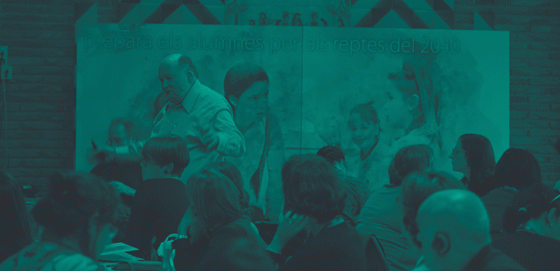Although there is a broad consensus on the need to include Critical thinking in school and university curricula, there is no consensus on how to do it effectively in order to achieve transfer to all areas of students’ lives.
The experts who participated in the 1990 Delphi agreed on the following recommendation regarding the presence of Critical thinking in the curriculum:
“The school curriculum should pay special attention to critical thinking, and critical thinking skills and dispositions should be learning objectives. Dispositions and justifying and evaluating reasoning should be an integral aspect of the teaching method at the primary and secondary levels. Critical thinking should be integrated into all subject areas. A minimum level of performance in critical thinking should be set at each level of education”.
Dispositions and justifying and evaluating reasoning should be an integral aspect of the teaching method at the primary and secondary levels

Another of the most widespread proposals, especially at the university level, is that developed by Robert Ennis (2013) for American colleges. Some key ideas from his contribution are:
- Importance of educating for transfer to all areas of life beyond the educational stage. In this sense, Ennis emphasises the necessary involvement of all teachers and a vision of neutral critical thinking in reference to the different disciplines. This does not mean that each discipline contributes in a very positive way to the development of a specific aspect of critical thinking. For Ennis, for this to happen, time must be devoted to teaching for transfer to new contexts, ensuring that concepts, principles and criteria are made explicit.

Time must be devoted to teaching for transfer to new contexts, ensuring that concepts, principles and criteria are made explicit
- In reference to the two ways of integrating critical thinking indirectly into the teaching of any discipline: “immersion” or “infusion”. For Ennis, “immersion” fails to transfer to other disciplines and to ordinary life, for, while some students do it, many do not. “Infusion”, however, by making the principles at stake explicit, is more effective in terms of transfer.
- In order to strengthen the principles of Critical thinking, the “infusion” method should be complemented by some direct training course in which the content is the skills themselves without specific content.
- The “infusion” of critical thinking in the teaching of a discipline has a positive impact on students’ learning because although at first, it may seem to compete with the content of the subject itself, taking time and attention away from it, its application entails more significant effort and involvement on the part of the student, and they end up learning and retaining the specific content better.
The “infusion” of critical thinking has a positive because entails more significant effort and involvement on the part of the student

- It is vital to have a glossary that serves as a common theoretical framework of essential terms to avoid ambiguity and confusion.
- It is essential to have good coordination between all the teaching staff in order to make the cross-curricular training of skills and dispositions coherent.
As a general rule, education systems tend to integrate Critical thinking into school curricula using one or more of the following variants:
- Cross-cutting and indirect introduction across the curriculum. In this case, Critical thinking is applied in all domains of knowledge throughout all educational stages. This allows not only the development of competence but also a greater understanding of the contents and their competent application. The two most widespread versions are a) to do so by infusing thinking into the learning of content (explicit mode) which involves explicitly detailing the skills and dispositions, converting them into assessable educational objectives; b) to do so by immersing CP in the educational objectives of each domain (implicit mode). In the latter case, skills and dispositions are not assessed though they are implicitly worked on. In this case, it is up to the teacher to ensure their development while teaching the content.
- Direct introduction through a particular course or discipline.
- Mixed variants combining several options.
Before deciding on one or the other option, it is necessary to bear in mind that, although initially, the developmental programmes were direct instruction and constituted training separate from the curricular areas of knowledge, many of these programmes were launched in the USA and Canada in the last quarter of the 20th century. Many of these programmes were implemented in the USA and Canada in the last quarter of the 20th century, but they did not produce the expected results. Students learned skills but not the competence to think critically in the various areas of their lives. Nowadays, this practice is residual mainly, and the trend is to seek the development of Critical thinking as a cross-cutting competence in any domain of knowledge. Critical thinking is a competence and, as such, in order for its learning to be effective, it is crucial that it is done in a meaningful way, i.e. by applying it to knowledge that the learner already has, contextualised in real situations.

Critical thinking is a competence and, as such, it is crucial that it is applied to knowledge that the learner already has, contextualised in real situation
In some cases, curricula reach a high level of concreteness; in others, they only provide general guidelines. In all cases, it is common for schools to rely on educational programmes focused on the development of thinking. Some of the most widespread ones are listed below, according to Saiz (2018):
- TBL, Thinking Based Learning (Robert Swartz). Method for infusing critical thinking skills into the curriculum (Swartz, 1994). It is the most homogeneous and representative of the explicit infusion model.
- Philosophy for Children (Lipman). This is the oldest and most ambitious. It is based on Lipman’s theory of “higher thinking” which is based on the interaction of critical and creative thinking. Based on philosophy as a fundamental discipline, it applies direct teaching with a high metacognitive component and the aim of developing reflective capacity. It consists of a complete and systematic curriculum from 3 to 18 years of age.
- Dialogical Thinking (Richard Paul). This is a direct method outside the domains of knowledge, with a strong focus on inquiry and metacognition. The Critical Thinking Foundation, created by Paul and Linda Elder, has become a reference in the teaching of critical thinking with its annual international conference on Critical Thinking.
- Habits of Mind. This programme for the development of habits of mind, created by Arthur Costa and Bena Kallik, is oriented towards the development of a positive attitude towards Critical thinking and includes didactic strategies for the development and evaluation of 16 habits of mind necessary to solve the complex problems of the 21st century. (Costa and Kallik, 2008)
- Cultures of thought, Project Zero. Aimed at creating suitable environments to make thinking visible and favour the development of intellectual habits in students.
- FRISCO (Robert Ennis). This programme proposes a general guide to critical thinking: Focus, Reasons, Inference, Situation, Clarity, Overview, for the application of thinking skills. Like the two previous programmes, it is a straightforward, out-of-discipline approach. It includes the development of critical thinking dispositions.
- CRRAR (Center for Research in Reasoning, Argumentation & Rhetoric). Developed at the University of Windsor, Canada, by Govier, Johnson, Blair and Walton. It works along argumentative lines with the aim of developing the reasoning skills needed to think critically. It focuses on argumentation and considers thinking in action to be of little relevance to CP development.
- Halpern-based methods. The approach followed by numerous programmes based on Diane F. Halpern’s guidelines for the development of critical thinking. It is teaching with the following characteristics: 1) identifiable and definable skills; 2) specific strategies; 3) metacognitive; 4) attending to dispositions; 5) including good inter-domain practice to encourage transfer.
References
Moreno, A. (2021). “Critical thinking and creativity. Two key lessons for the knowledge society in the age of innovation”. Delphi expert report.
https://impulseducacio.org/en/critical-thinking-key-education-era-innovation/
You might also like








Leave A Comment